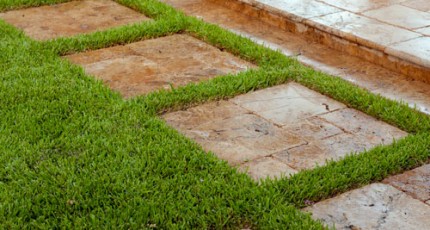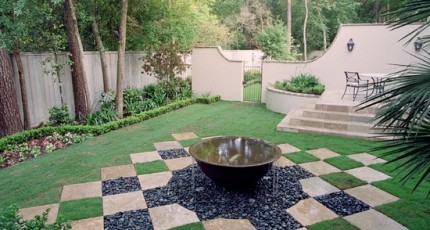Hardscape
The term “hardscape” refers any non-organic landscape element that is deliberately planned and constructed. It gets its name from the nature of the materials used to build the many forms that constitute this family of landscaping elements. Most construction materials used in these projects are very hard, and create lasting, durable, and resilient fixed that serve special purposes and add beauty and aesthetic impact to the yard.
Hardscape structures are almost always the first forms built when the time comes to actually implement a residential landscaping design project. This is due to the powerful visual impact they carry which lends itself so well to the establishment of order and system throughout the property. Though non-organic themselves, these structures are crucial to the proper showcasing of vibrant colors of garden design and the lush shades of green of a well-manicured lawn.
The types of hardscape structures that can be added to a yard are truly many and varied. Elements such as paved sidewalks, stepping stone pathways, brick walkways, atriums, courtyards, and custom patios are just a few examples. Many people also like to have more elaborate and sophisticated structures built, such as outdoor fireplaces, custom fountains, sports courts, stairways and steps, and garden pergolas.
There are also structures such as retaining walls and masonry planters that serve a vital practical purpose as well as adding vertical impact to the flat Houston landscape.
Any material that provides a firm, durable surface can be used to create a hardscape. Preferably, this material should be decorative as well as functional. Stone is still the most popular material after thousands of years. It looks natural and can be used to compliment any landscape design theme. Another popular material is concrete. It can be colored and stained to mimic stone, or it can be made to stand out as a unique, decorative statement all its own. Wood and brick are two other materials that have been around for centuries and show no sign of going away in the years to come.
In terms of practicality and aesthetics, the benefits that hardscapes add to landscaping are almost too numerous to count. Some of the more notable of these advantages are discussed as follows:
- Pathways and walkways create transition by providing clear, recognizable transit areas through which traffic moves from one point of interest to another.
- Paths can also create zones of interest and make a yard look bigger by altering the perspective and depth of the scene.
- Architectural walls can create borders around vegetation and activity zones, magnifying the impact of the vegetation in the process.
- Retaining walls can be used to change the grade of the Houston landscape.
- Courtyard walls create enclosed spaces for privacy and conversation.
- Garden pergolas, with their lattice walls, can screen the view with such elements as lattice walls or raftered ceilings partly open to the stars
- Custom patios establish entertainment and seating areas, such as swimming pool patios, luxury spas, and outdoor fireplaces
- Stairways and steps leading to and from outdoor buildings create drama and a sense of grand entrance.
- Arbors create shade and comfort in the hot, Houston summer sun.
- Masonry constructs add vertical impact that lifts the property above the aesthetic norm.
- Front yard walkways and custom driveways add curb appeal to the edifice of the home.
In all of these examples, we can see how equally important the aesthetic element of hardscape is to its functional element. Ideally, there should always be a purposed served by a structure in a way that also pleases the eye. Some forms, however, are for all intents and purpose pure decoration and nothing more.
An excellent example of such would be outdoor water features such as custom fountains. Very small architectural walls around patios and morning gardens also do little to create enclosure or true privacy per se, but lend themselves very well to the sense of special place that is set apart visually and distinctively from the rest of the yard.
Permeable Concrete Pavers
Interlocking Paving Stones Made from Concrete
Custom Patio
Patio Ideas

Paver Patio Design
Flagstone Patio Design

How Hardscape Design Compliments Houston Homes

